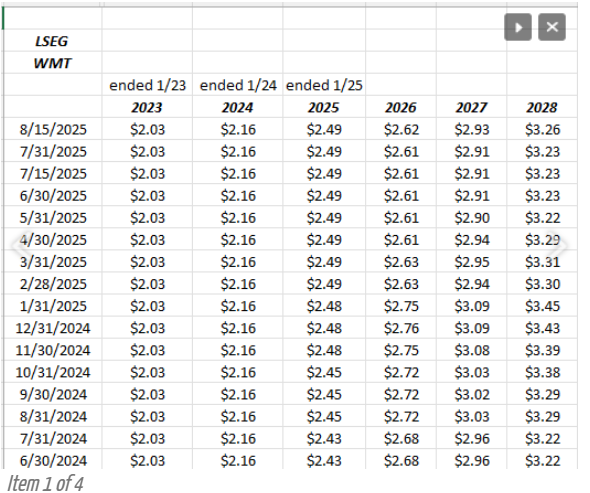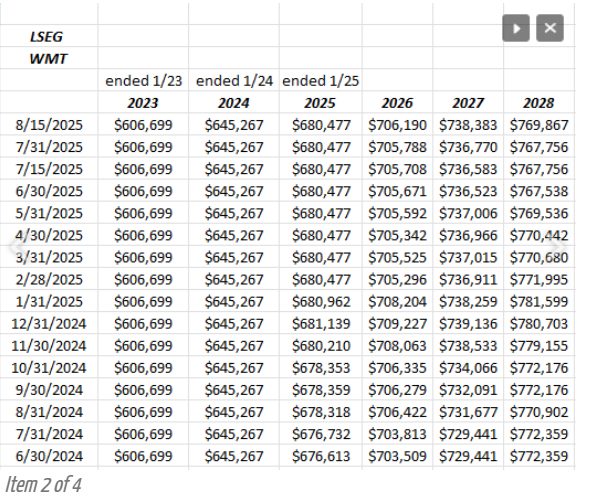Walmart (NYSE:), the retail juggernaut is expected to report their fiscal Q2 ’26 financial results before the opening bell on Thursday morning, August 21st, and those consensus estimates are expecting $0.76 in earnings per share on $176 billion in revenue for expected y-o-y growth of 13.5% and 4% respectively. (Those estimates could change before Thursday of this week.)
Walmart’s operating income is expected at $8.7 billion for an expected 10% y-o-y growth.
In fiscal Q1 ’26, Walmart’s “comp’s” ex-gas of 4.5% were driven by wellness and grocery. Grocery is anywhere from the low 50% to mid 60% of total Walmart revenue, so the Amazon (NASDAQ:) announcement this week, noting they were expanding their same-day retail grocery delivery as part of Prime, probably picked up some heads in Bentonville, Arkansas.
While Amazon has AWS, both Amazon and Walmart are on track to print $700 billion in revenue this year, which signifies AMZN’s ascension into rarified revenue air. Walmart is traditionally ranked #1 within the SP 500 in annual revenue, and historically it’s only competition in that ranking comes from Exxon-Mobil when the price of spikes, so the fact that Amazon has finally caught up to Walmart after 25 years, is significant, and probably says a lot about Walmart’s stock price performance from 2010 to 2023.
EPS and Revenue Estimate Revisions

The big issue with Walmart the last few quarters is their gross margin, which is likely tariff-related. Walmart’s gross margin (GM) fell 34 bp’s y-o-y in fiscal q4 ’25 (ended January ’25) and then again fell 86 bp’s y-o-y in fiscal Q1 ’26 for a total of 120 bp margin compression, over two quarters. While a little worrisome, that’s still above the January ’23 quarterly report which saw gross margin fall 159 bp’s sequentially and 168 bp’s y-o-y, when grocery inflation was in the mid-teens, and Walmart saw increased fuel and supply chain cost pressure.
In both revenue and EPS columns, we are seeing volatility in the revisions, which is analysts likely trying to get their arms around tariff pressure and then working out the math.
To be frank with readers, the preference around the EPS revisions would be to have seen steady positive revisions, which, while usually small, are still typical of Walmart’s quarters.
Changes at Walmart
The big changes to Walmart operationally the last few years are Walmart Connect, which is an omnichannel approach to help Walmart customers reach Walmart’s sizable customer base via advertising. What’s puzzling (at least for me anyway) is that Walmart reported their global advertising biz grew 29% in fiscal q4 ’25 (ended January ’25) while it was reported that Walmart Connect grew 24% y-o-y so there is some slight differentiation between the two channels, which I don’t yet understand.)
Walmart Connect and Walmart advertising is what is hopefully expected to be “margin-rich” dollars (margins on advertising exceed the margins on the normal merchandising business) for Walmart as both Connect and advertising grow, although the retail giant hasn’t yet put a number on what percentage of total Walmart revenue advertising and Connect comprise.
A 3rd important change announced in the Spring of ’23, was the warehouse supply chain automation which also was expected to help Walmart’s operating margin over time. In the last few quarters Walmart has mentioned on one of the conference calls that the supply-chain automation process was about 50% complete, from which I concluded there is some savings still to be had in terms of reduction of operating expenses.
Finally, while long-term in nature, Walmart’s e-commerce business is now fully 20% of Walmart’s $700 billion of revenue and has brought it up to a least a similar level with Amazon. What’s struck me reading the conference call notes is that Walmart seems to have identified a niche in “under 1-hour” or “under 2-hour” delivery of immediately-needed items which is growing in demand within certain communities. (My own experience with Walmart Home or the basic service is a little less satisfactory, but that will be saved for another time.)
Finally, if anyone is worried about Walmart’s ability weather price or tariff pressure, and Walmart’s ability manage that environment. here’s a clip of our internal spreadsheet of Walmart showing “comp” data as well as “average ticket” and “traffic” and what Walmart experienced during Covid:
For comparison, here’s the recent Walmart comp data and average ticket vs traffic: Walmart is an exceptional operator, which it normally doesn’t get much credit for in terms of WallStreet commentary.
Walmart is an exceptional operator, which it normally doesn’t get much credit for in terms of WallStreet commentary.
We have modeled Walmart since the mid-1990’s, and looking at the comp and “traffic vs ticket” data around the 4th calendar quarter of 2008 and early 2009, Walmart never posted a negative “comp” in one of the worst recessions since the Great Depression.
Valuation
Walmart always looks expensive on a PE basis, and this quarter is no exception with expected earnings growth expected to slow to 4% in fiscal ’26, with the stock trading at 37x the fiscal ’26 estimate. It’s clear the tariffs and the Trump Administration trade policy is having some impact on Walmart given its merchandising expertise around the globe.
On a cash-flow basis, Walmart is trading at 18x, but that’s still small consolation given the multiple. The reason the cash-flow multiple is so much lower than the PE multiple is the significant depreciation expense every quarter from 10,500 stores around the world.
At $100 per share, the stock is trading at about a 10% premium to perceived intrinsic value ($87 per share), but I do not think Walmart’s intrinsic value is as low as Morningstar’s $62 fair value estimate. The $62 estimate gives no value to the stability and consistency of earnings growth for the largest retailer in the US, nor the dominance in the grocery channel, which is high traffic, lower margin, and is a perfect fit with Walmart’s retail model. Our internal valuation model puts a fair value on Walmart near $89 – $90 per share, so the stock today isn’t nearly at a big enough premium to sell a big portion, but certainly not cheap enough to add to the position, i.e. in Warren Buffett terms, there is a little to no margin of safety on Walmart’s stock price today.
In the first half of last decade i.e. from 2010 to 2015, Walmart’s operating margin gravitated between 5% and 6%. Then after 2016, it fell into the 4% range where it has remained.
July and October ’24 quarters saw Walmart’s operating margin at 4.69% – 4.70%.
A move into the low 5% range for Walmart’s operating margin would indicate improvement on the cost and flywheel revenue fronts.
Summary / Conclusion
As readers can tell, the big focus of any investor in Walmart today should be on the “flywheel” revenue model (new and different areas like Walmart Connect and advertising driving additional revenue growth) as well as cost containment and rationalization, which Walmart has always been almost religious about, although the fulfillment center automation allows analysts to put a dollar savings on the upgrade).
In fiscal Q1 ’25 (that’s the quarter ended April ’24) , Walmart noted that 1/3rd of their operating income improvement came from advertising, Connect, membership, data ventures, etc. That should continue over time, although tariffs could have a bigger near-term impact.
Walmart is looking to boost the operating margin over time, by attacking the operating margin from both a cost and revenue perspective.
Here’s a Walmart post from February ’25 that includes all historical articles on Walmart, which will allow the reader to follow the thought progression on the stock.
Amazon and Walmart’s business models have been converging for years. Amazon’s entry into the grocery business via Prime delivery probably won’t mean much for the next 24 months, but it will definitely bear watching.
Thanks for reading.
***
Disclaimer: None of this is advice or a recommendation, but only an opinion. Past performance is no guarantee of future results. Readers should gauge their own comfort with portfolio volatility and adjust accordingly.